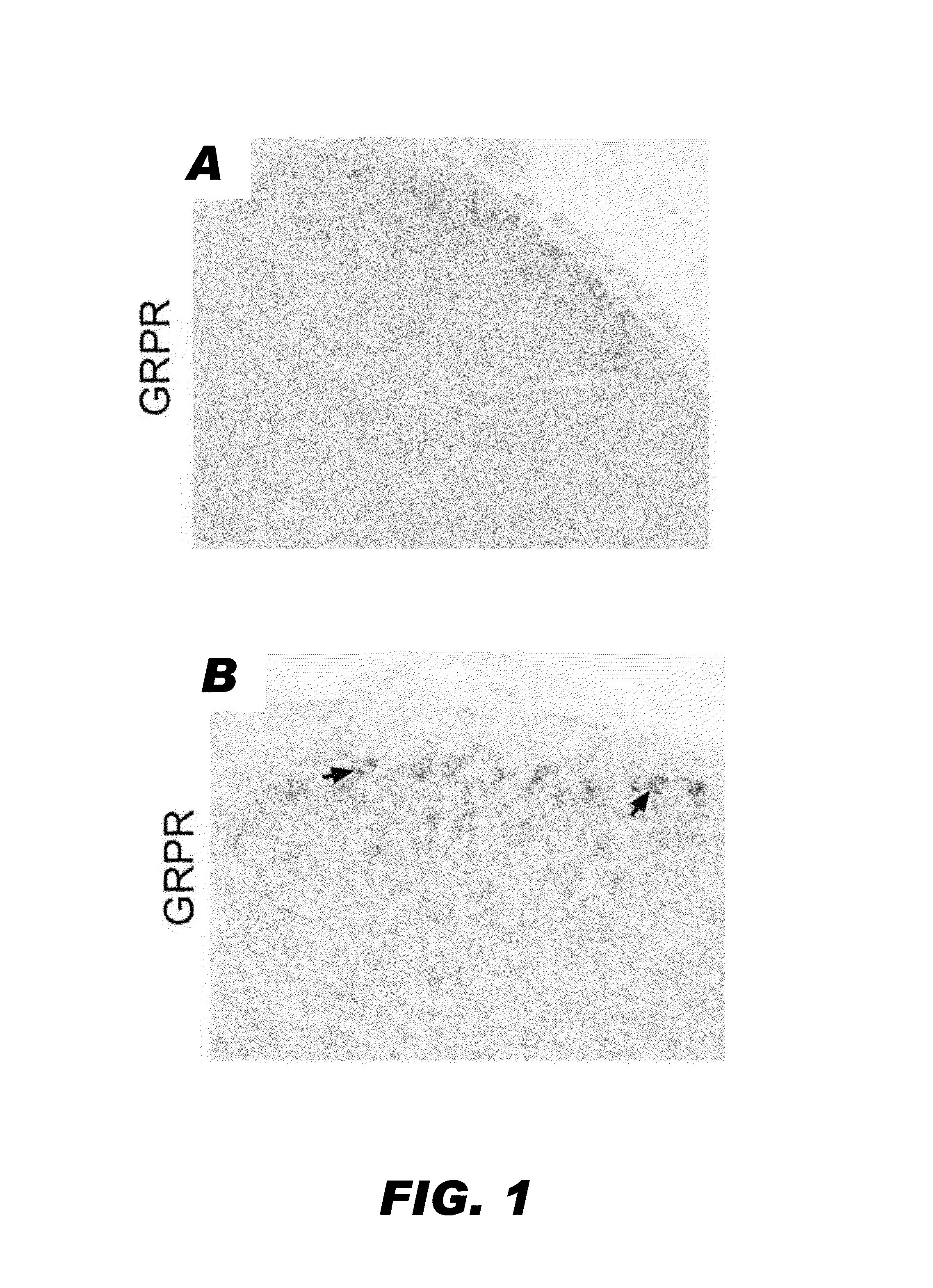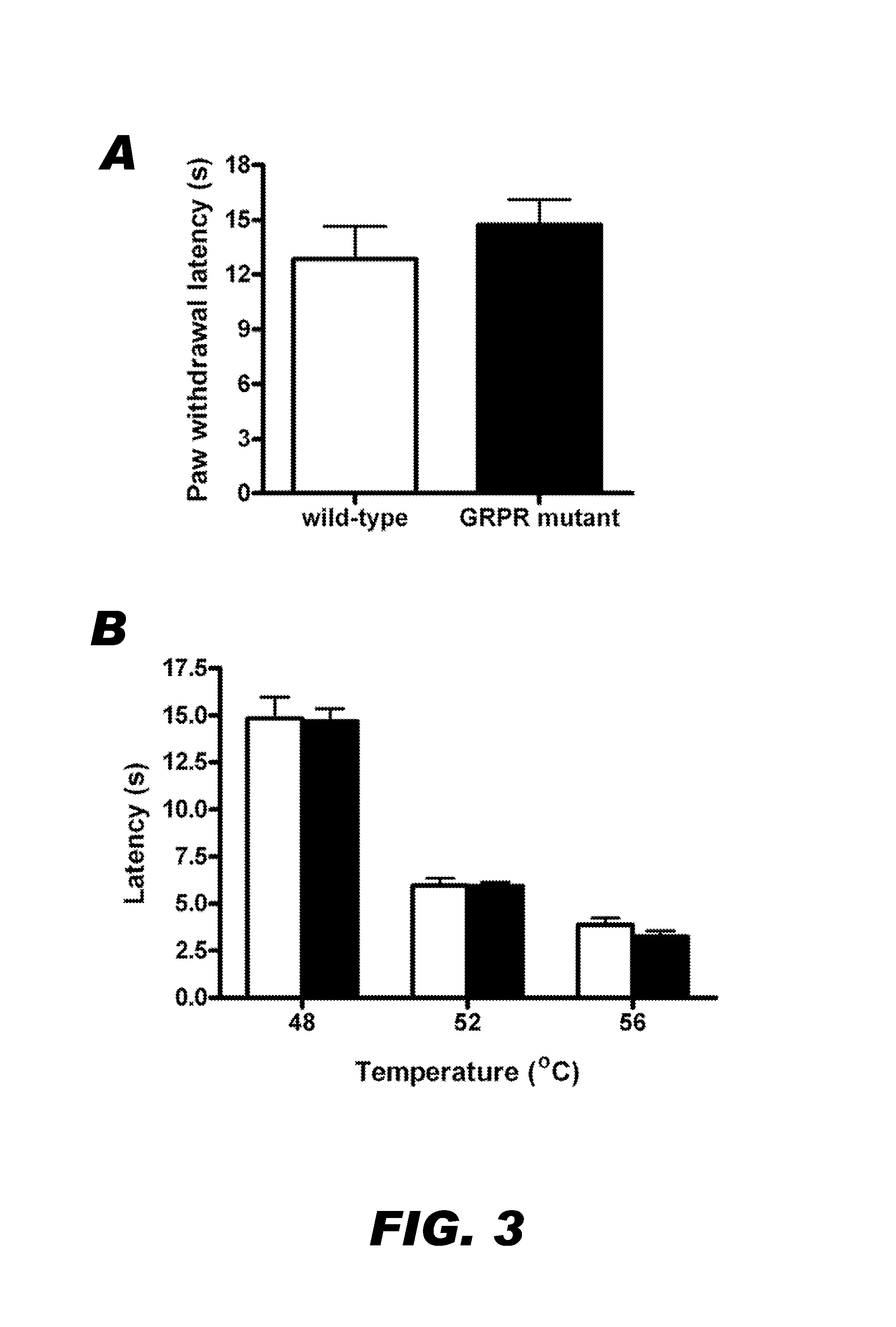Compositions and methods for treating pruritus
a technology applied in the field of compositions and methods for treating pruritis, can solve the problems of affecting the normal sleep pattern and daily activity, the desire to scratch, and the clinical problem of chronic itching, so as to reduce the incidence of pruritus
- Summary
- Abstract
- Description
- Claims
- Application Information
AI Technical Summary
Benefits of technology
Problems solved by technology
Method used
Image
Examples
example 1
Expression of GRPR in the Spinal Cord
[0122]To identify novel genes that are expressed in the dorsal horn of the spinal cord, differential dorsal / ventral screening was performed (Li et al., 2006). The expression of the GRPR gene was found to be restricted to lamina I of the spinal cord (FIG. 1). GRPR expression is located in the most superficial layer of the dorsal horn (FIG. 1). No GRPR+ cells are found in the deep dorsal horn and ventral horn of the spinal cord. Such highly specific expression of a gene in lamina I but not in other regions of the dorsal horn is unprecedented. Because lamina I neurons have been implicated in pain and itch sensation, we postulated that GRPR+ neurons may be important for mediating the itch sensation.
example 2
Expression of GRP in a Subset of Peptidergic Dorsal Root Ganglion (DRG) Neurons
[0123]GRP is expressed in a subset of small and medium sized DRG neurons (FIG. 2a), and is colocalized with peripherin, a marker for unmyelinated fibers (FIG. 2b). GRP is also colocalized with CGRP or substance P, but is neither costained with Griffonia simplicifolia isolectin B4 (IB4), a nonpeptidergic marker, nor with myelinated marker NF200 (FIG. 2c, d, e, data not shown). Furthermore, about 80% GRP+ neurons express TRPV1 in the DRGs (data not shown). GRP+ fibers project to the superficial layer (laminae I and II outer layers) of the dorsal spinal cord, to which SP+ fibers and CGRP+ fibers project (FIG. 2f). GRP mRNA is not found in the superficial layer of the spinal cord.
example 3
Normal Locomotor Activity, Acute and Formalin Pain Behaviors of GRPR Mutant Mice
[0124]To examine whether GRPR is required for locomotor activity, GRPR mutant and wild-type littermate mice were examined in an open field test. There was no significant difference in locomotor activity between the two genotypes (FIG. 3f). To assess whether GRPR may contribute to pain sensation, the thermal, mechanical, and inflammatory (formalin) pain responses of GRPR mutant mice were examined. We found the GRPR mutant mice and wild-type mice did not differ in any of the pain behaviors examined (FIG. 3a-e), suggesting that GRPR is not required for transmission of noxious information.
[0125]To further examine pain behaviors of GRPR mutant mice in persistent pain models, the mechanical hypersensitivity produced by hindpaw injection of complete Freund's adjuvant (CFA) was examined, and no significant difference was found between GRPR mutant and wild-type littermates (FIG. 4a). To examine if GRPR is require...
PUM
| Property | Measurement | Unit |
|---|---|---|
| molecular weight | aaaaa | aaaaa |
| volume | aaaaa | aaaaa |
| diameter | aaaaa | aaaaa |
Abstract
Description
Claims
Application Information
 Login to View More
Login to View More - R&D
- Intellectual Property
- Life Sciences
- Materials
- Tech Scout
- Unparalleled Data Quality
- Higher Quality Content
- 60% Fewer Hallucinations
Browse by: Latest US Patents, China's latest patents, Technical Efficacy Thesaurus, Application Domain, Technology Topic, Popular Technical Reports.
© 2025 PatSnap. All rights reserved.Legal|Privacy policy|Modern Slavery Act Transparency Statement|Sitemap|About US| Contact US: help@patsnap.com



